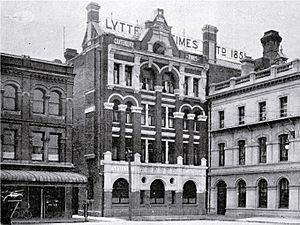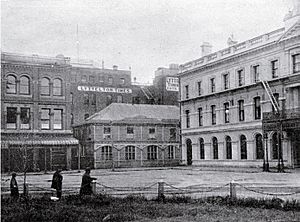Lyttelton Times Building facts for kids
Quick facts for kids Lyttelton Times Building |
|
|---|---|

The façade of the Lyttelton Times Building in December 2008.
|
|
| Alternative names | Base Backpackers |
| General information | |
| Type | Initially commercial, now hostel |
| Architectural style | Chicago School |
| Location | Cathedral Square, Christchurch Central City |
| Address | 56 Cathedral Square |
| Town or city | Christchurch |
| Country | New Zealand |
| Coordinates | 43°31′49″S 172°38′14″E / 43.5302°S 172.6373°E |
| Construction started | 1902 |
| Completed | 1904 |
| Demolished | 2011 |
| Client | Lyttelton Times |
| Technical details | |
| Structural system | Load bearing walls |
| Design and construction | |
| Architect | Sidney and Alfred Luttrell |
| Designated: | 16-Dec-1994 |
| Reference #: | 7216 |
The Lyttelton Times Building was a famous building in Christchurch Central City, New Zealand. It was located at 56 Cathedral Square. This building was once the main office for the Lyttelton Times newspaper. This newspaper was the oldest in New Zealand before it stopped publishing in 1935.
The building was designed in the Chicago School style. It was very important for its history and design. Because of this, it was listed as a Category I heritage item by New Zealand Historic Places Trust. Its special number was 7216. Before it was demolished, the building was used as a backpackers' hostel and a restaurant. Sadly, it was pulled down after the big 2011 Christchurch earthquake in February 2011.
Contents
The Lyttelton Times Newspaper: A Quick Look
The Lyttelton Times newspaper was created by the Canterbury Association. This group planned the settlement of Canterbury. The first newspaper was printed on 11 January 1851. This happened shortly after the first settlers arrived in December 1850.
The newspaper first started in the port town of Lyttelton. Later, in 1863, its main office moved to the bigger city of Christchurch. Another newspaper, The Press, had already started in Christchurch in 1861. This made them competitors.
Building History: From Newspaper to Hostel
The Lyttelton Times newspaper had an office on Gloucester Street since the 1850s. This land went all the way through to Cathedral Square. When the main office moved from Lyttelton, a two-storey wooden building was built on the Cathedral Square side.
The newspaper grew bigger and needed more space. So, in 1884, a new building was built on the Gloucester Street side. This building is now known as the Star Building. The newspaper kept growing, so in 1902, two architects named Sidney and Alfred Luttrell were asked to design a new building for the Cathedral Square side.
Designing the New Building
The Luttrell brothers had just moved to Christchurch from Tasmania. The Lyttelton Times Building was their first major project. It helped them become well-known architects and builders. They designed the building in the Chicago School style. This was the first time they used this style in New Zealand.
They used the look of the Chicago School style for the outside of the building. However, they did not use the usual steel frame structure inside. Instead, they used strong load-bearing walls to hold up the building. Later, for other buildings like Manchester Courts in Christchurch, they used more of the Chicago School's structural design.
Construction of the Lyttelton Times Building began around 1902. It was finished in 1904. At that time, it was the tallest building in Cathedral Square. Only the tower of ChristChurch Cathedral was taller.
Early Uses and Changes
At first, some rooms in the Lyttelton Times Building were used by the nearby Warner's Hotel. This hotel was built in 1901 after an earlier hotel burned down. But this arrangement did not last long. The hotel guests were kept awake by the loud printing presses in the newspaper building.
The noise was so bad that part of Warner's Hotel, next to the Lyttelton Times Building, was removed in 1917. A new theatre called the Liberty Theatre (later the Savoy) was built in its place.
Newspaper Changes and Demolition
In 1929, the Lyttelton Times newspaper changed its name to Christchurch Times. But in 1935, this newspaper stopped printing. There was a lot of competition in Christchurch at the time. There were two morning papers and two evening papers. The Press, which is still printed today, became the main morning newspaper.
The Lyttelton Times Company changed its name to New Zealand Newspapers Ltd. They continued to publish an evening paper called the Star-Sun. This was a continuation of their older evening paper, The Star, which had been published since 1868. The Star-Sun was printed in the Lyttelton Times Building until 1958. Then, the newspaper moved to a new location and changed its name back to The Star. It is still published today as a free newspaper on Wednesdays and Fridays.
Protecting the Building and Its Fate
In 1994, the Lyttelton Times Building was recognized as a heritage building by the New Zealand Historic Places Trust (NZHPT). This meant it was important to protect.
However, in 1997, the owner of the building wanted to pull it down. The owner also wanted to demolish the Star Building and Warner's Hotel. At that time, only the Lyttelton Times Building was officially protected. A commissioner allowed the Lyttelton Times Building to be demolished. They also allowed the Star Building to be demolished, but its front (façade) had to be saved. The request to demolish Warner's Hotel was not approved.
But the Environment Court later stopped the demolition of the Lyttelton Times Building. Then, the Christchurch Heritage Trust bought the building. They turned it into a backpackers' hostel and a restaurant.
After the big 2011 Christchurch earthquake in February 2011, the Lyttelton Times Building was not initially on the list of buildings to be demolished. But in August 2011, it was reported that the building had been pulled down. The historic part of Warner's Hotel also needed to be demolished. The nearby The Press Building was demolished in July 2011.



